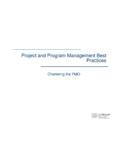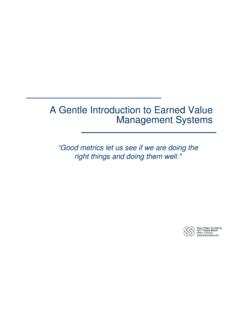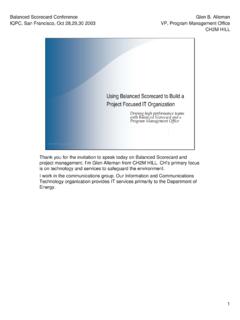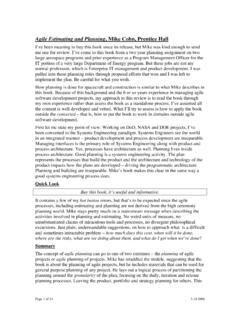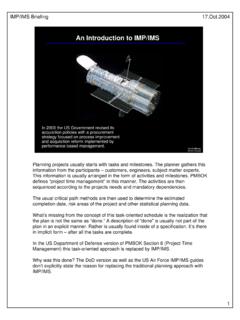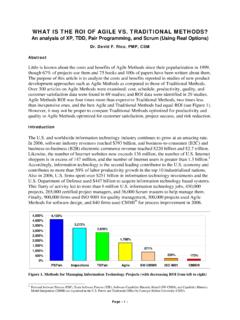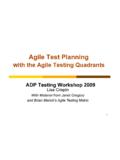Transcription of Agile Project Management Methods for ERP: How …
1 In Extreme Programming and Agile Methods : XP/ Agile Universe 2002, pp. 70 88, Springer Verlag, LNCS 2418, Editors, Don Wells and Laurie Williams. Agile Project Management Methods for ERP: How to Apply Agile Processes to Complex COTS Projects and Live to Tell About It Glen B. Alleman Niwot Ridge Consulting Niwot, Colorado 80503 Abstract: The selection, procurement, and deployment of an Enterprise Re-source Planning (ERP) system is fraught with risk in exchange for significant business and financial rewards [26]. In many cases the packaged ERP product does not provide the entire solution for the business process. These gaps can be closed with third party products or by customizing existing products.
2 Manage-ment of this customization, as well as the selection of the core ERP system has traditionally been addressed through high ceremony, science based, Project Management Methods [13]. Well publicized failures using this approach cre-ates the need for new Methods for managing ERP projects [11]. This compen-dium paper describes an alternative to the traditional high ceremony IT pro-jects Management Methods . Although many of the Methods described are not new assembling them into a single location and focusing on a single issue pro-vides the tools to make decisions in the presence of uncertainty, focus on the critical success factors, and address the managerial and human side of Project Management Agility allows the Project Management Methods as well as the system to be adaptively tailored to the business needs.
3 1. Introduction Using accepted standards for doing business significantly reduces the coordination efforts between business partners as well as internal information and workflow proc-esses [46]. ERP provides the means to coordinate and manage this information, by integrating enterprise information and business processes. Managing an ERP Project is not the same as managing a large scale IT Project . IT projects emphasize requirements elicitation, detailed planning, execution of identified tasks, followed by end to end delivery of business functionality. Even though this Project methodology faces difficulty when scaled to larger projects, applying it to ERP projects creates further difficulties.
4 The ERP environment faces constant change and reassessment of organizational processes and technology [67]. The Project Management method used with ERP de-ployments must provide adaptability and agility to support these evolutionary proc-esses and technologies [33]. The use of Agile Methods in the ERP domain provides: Increased participation by the stakeholders. Incremental and iterative delivery of business value. Maximum return on assets using a real options decision process. What s the Problem Here? The major problem with software development (and deployment) is managerial, not technical. The notion that Commercial Of The Shelf (COTS) products are the solution to busi-ness problems out of the box has pervaded the literature [13].
5 The application of scien-tific Management principles to these projects is understandable. The use of predictive strategies in this environment is inappropriate as well as ineffective since they do not address the emergent and sometimes chaotic behaviors of the market place, the stake-holders, and the vendor offerings. This paper describes a method of augmenting structured Project Methods with agility to produce a new approach to managing ERP projects. This Agile approach requires analytical tools for making the irrevocable decisions in the face of uncer-tainty found in the ERP domain. This approach provides Methods for dealing with the interpersonal, stakeholder, and business process issues that arise in the rapidly chang-ing ERP environment.
6 Agile Methods provide the means to deliver not just pretend progress but real pro-gress, measured as business value to all the participants buyer, seller, and service provider. What is an ERP Project ? The term Enterprise Resource Planning, coined in the early 1990 s, is a software application suite that integrates information and business processes to allow data entered once to be shared throughout an organization. While ERP has its origins in manufacturing and production planning systems, it has expanded to back office func-tions including the Management of orders, financials, assets, product data, customer relations, and human resources.
7 Thinking about an ERP Project as a large scale IT deployment leads to several unacceptable propositions [13]: Spend $2 million, $20 million, or even $200 million up front for a new technology with a 50% to 70% probability of a partial or complete write off of the investment. If unwilling to write off the investment, double the original investment to complete the Project successfully. ERP Project Management and Normal Science Modern Project Management is heavily influenced by the belief that a Project man-agement process can be improved by scientific Methods [16, 26]. These include the beliefs create the myth that: Clear cut investment opportunities with an explicit purpose, beginning, duration, and end can be identified early in the Project .
8 Low opportunity costs for each business or technical decision exist, in most in-stances with a reversible decision process. Feasible, suitable, and acceptable Project attributes can be identified. Accurate predictions of Project duration and resource demands are possible once the requirements have been defined. Worst case consequences can be determined in advance. The failure of the Project was due to lack of skills rather than inappropriate feasi-bility, suitability, or acceptability of the solution. This is a normal science view of Project Management . In the ERP domain it can be replaced with a post modern view 1, in which there are: Highly uncertain facts about the Project attributes.
9 Constant disputes about the values and expectations. High decision stakes with irreversible consequences. Urgently needed decisions in the presence of insufficient information. Outcomes that affect broad communities of interest. Agile Methods do not mean that the normal science model is irrelevant, just that such a model is applicable only when uncertainty and decision stakes are low [37]. A fundamental attribute of post normal science is the reliance on heuristics [32, 51]. Using heuristics to guide the development using Agile Methods allows the Management of ERP projects to be placed in a post normal science context. ERP Projects are New Ventures The Agile Methods used to manage an ERP Project can be taken from the Venture Capitalist approach rather than the IT Managers approach [3, 7, 8].
10 These Methods include: Staged Investments capital must be conserved. Managed Risk all participants must share the risk. It s the people stupid the composition of the participants is the critical success factor. 1 Classical science and conventional problem solving were labeled normal science by Kuhn [53]. Post Normal science acknowledges there is high system uncertainty, increasing deci-sion stakes, and extends the peer review community to include the participants and stake-holders, who insure the quality and validity of the conclusions [37]. ERP is also Enterprise Transformation Three major processes make ERP projects significantly different from traditional IT projects.
